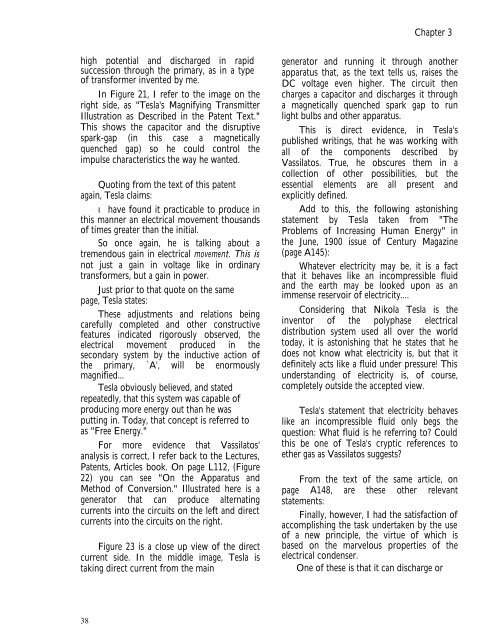Free%20Energy%20Secrets%20with%20Tesla%20patents
Free%20Energy%20Secrets%20with%20Tesla%20patents
Free%20Energy%20Secrets%20with%20Tesla%20patents
You also want an ePaper? Increase the reach of your titles
YUMPU automatically turns print PDFs into web optimized ePapers that Google loves.
high potential and discharged in rapid<br />
succession through the primary, as in a type<br />
of transformer invented by me.<br />
In Figure 21, I refer to the image on the<br />
right side, as "Tesla's Magnifying Transmitter<br />
Illustration as Described in the Patent Text."<br />
This shows the capacitor and the disruptive<br />
spark-gap (in this case a magnetically<br />
quenched gap) so he could control the<br />
impulse characteristics the way he wanted.<br />
Quoting from the text of this patent<br />
again, Tesla claims:<br />
I have found it practicable to produce in<br />
this manner an electrical movement thousands<br />
of times greater than the initial.<br />
So once again, he is talking about a<br />
tremendous gain in electrical movement. This is<br />
not just a gain in voltage like in ordinary<br />
transformers, but a gain in power.<br />
Just prior to that quote on the same<br />
page, Tesla states:<br />
These adjustments and relations being<br />
carefully completed and other constructive<br />
features indicated rigorously observed, the<br />
electrical movement produced in the<br />
secondary system by the inductive action of<br />
the primary, `A', will be enormously<br />
magnified...<br />
Tesla obviously believed, and stated<br />
repeatedly, that this system was capable of<br />
producing more energy out than he was<br />
putting in. Today, that concept is referred to<br />
as "Free Energy."<br />
For more evidence that Vassilatos'<br />
analysis is correct, I refer back to the Lectures,<br />
Patents, Articles book. On page L112, (Figure<br />
22) you can see "On the Apparatus and<br />
Method of Conversion." Illustrated here is a<br />
generator that can produce alternating<br />
currents into the circuits on the left and direct<br />
currents into the circuits on the right.<br />
Figure 23 is a close up view of the direct<br />
current side. In the middle image, Tesla is<br />
taking direct current from the main<br />
38<br />
Chapter 3<br />
generator and running it through another<br />
apparatus that, as the text tells us, raises the<br />
DC voltage even higher. The circuit then<br />
charges a capacitor and discharges it through<br />
a magnetically quenched spark gap to run<br />
light bulbs and other apparatus.<br />
This is direct evidence, in Tesla's<br />
published writings, that he was working with<br />
all of the components described by<br />
Vassilatos. True, he obscures them in a<br />
collection of other possibilities, but the<br />
essential elements are all present and<br />
explicitly defined.<br />
Add to this, the following astonishing<br />
statement by Tesla taken from "The<br />
Problems of Increasing Human Energy" in<br />
the June, 1900 issue of Century Magazine<br />
(page A145):<br />
Whatever electricity may be, it is a fact<br />
that it behaves like an incompressible fluid<br />
and the earth may be looked upon as an<br />
immense reservoir of electricity....<br />
Considering that Nikola Tesla is the<br />
inventor of the polyphase electrical<br />
distribution system used all over the world<br />
today, it is astonishing that he states that he<br />
does not know what electricity is, but that it<br />
definitely acts like a fluid under pressure! This<br />
understanding of electricity is, of course,<br />
completely outside the accepted view.<br />
Tesla's statement that electricity behaves<br />
like an incompressible fluid only begs the<br />
question: What fluid is he referring to? Could<br />
this be one of Tesla's cryptic references to<br />
ether gas as Vassilatos suggests?<br />
From the text of the same article, on<br />
page A148, are these other relevant<br />
statements:<br />
Finally, however, I had the satisfaction of<br />
accomplishing the task undertaken by the use<br />
of a new principle, the virtue of which is<br />
based on the marvelous properties of the<br />
electrical condenser.<br />
One of these is that it can discharge or












![[Pham_Sherisse]_Frommer's_Southeast_Asia(Book4You)](https://img.yumpu.com/38206466/1/166x260/pham-sherisse-frommers-southeast-asiabook4you.jpg?quality=85)




